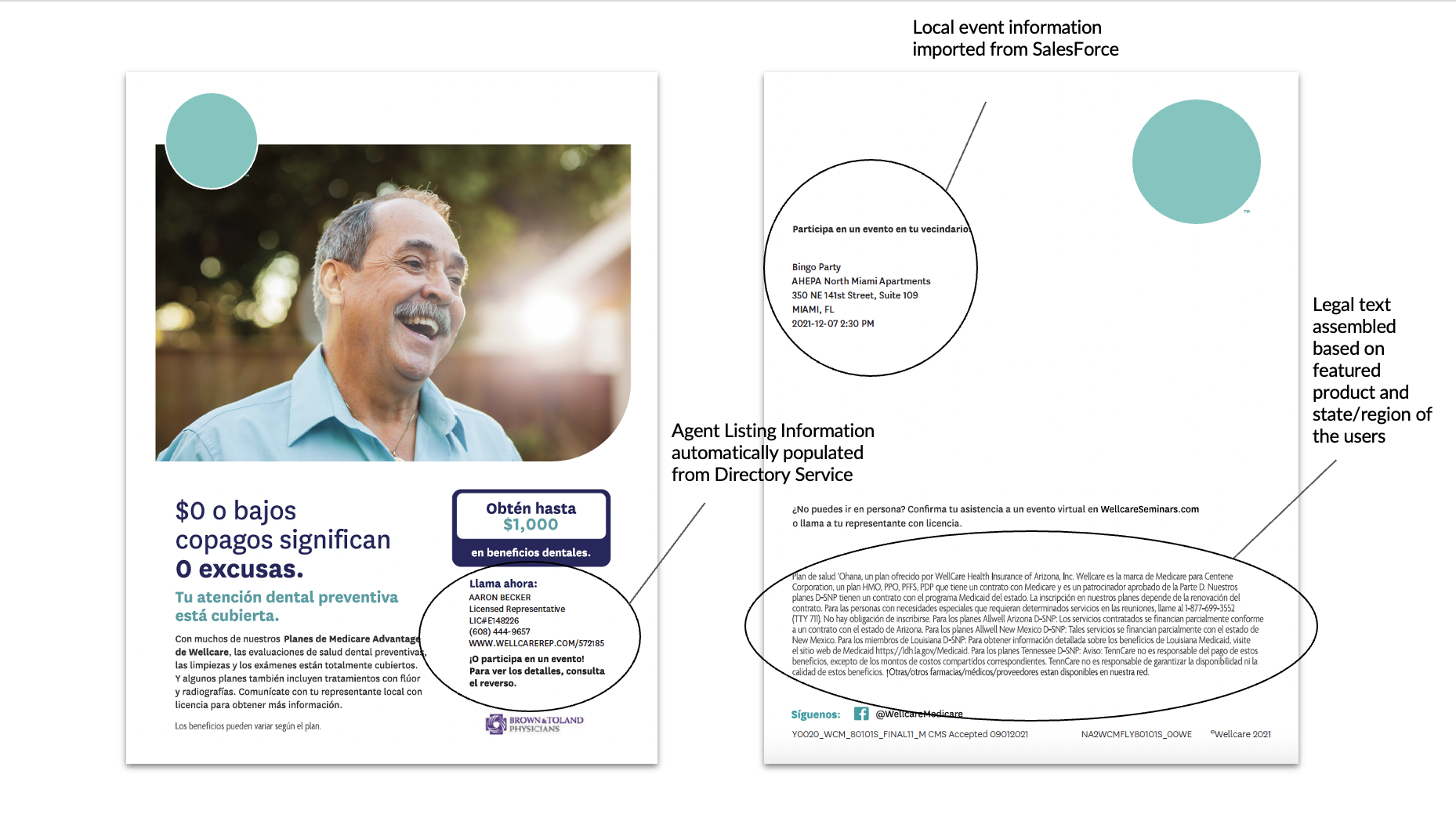A modular approach to content creation and delivery takes the best of your existing content and repurposes it in ways that make it easier for your target audience to find it, consume it, and act upon it. Traditionally, modular content has been used primarily in the web realm, to assemble web pages that are highly tailored to the interests of a specific kind of viewer. However, in recent years, forward-thinking firms—particularly those with distributed marketing networks (franchisees, resellers, dealers, salespeople, etc.).
But today, distributed brands need to take the promise of modular content one step further—by using it to help their local sales operations to cut through the clutter and overcome the scale advantage that mega-banks have when it comes to attracting customer attention.
The need for a local marketing edge is even more pronounced in banking these days, in the aftermath of the SVB/First Republic failures, which have sparked a "flight toward safety" that benefits the mega-banks while putting corporate relationships for community banks on much shakier ground.
In this post, we'll take a detailed look at the basic concept of modular content as it applies to the challenges of community bank sales and marketing specifically.
We will:
• suggest content topics that are rich with the potential for differentiation against mega-bank competitors.
• identify the most effective methods for transforming content into reusable components.
• outline the content management tools and techniques your community bank needs to build and sustain a successful modular content initiative.
• recommend some key metrics to help you determine the efficiency of your initiative and its impact on your operation over a reasonable (2-3 year) period of time.
What is Modular Content?
Modular content is a collection of marketing content assets—including headlines, body copy, images, charts, captions, and notes—that can be assembled quickly and easily to create powerful, multi-channel responses to individual marketing/sales opportunities or competitive threats.
To be clear: modular content goes far beyond that 20th-century notion of "mail merge". Modular content, executed properly, provides content experiences that: (a) feel to your prospective customers as if they have been developed in specific response to their individual needs; (b) reinforce the tone, manner, and personality of your brand; and (c) are easy for your local relationship managers to fine-tune and tailor to support the selling situation at the moment.
Let's dive a little deeper into this definition with a concrete example.
Let's say you are the CFO of a long-standing manufacturing business, in a mid-size Midwestern town—Ottumwa, Iowa, for example. Like many firms your size, you've located your company's primary cash operations with one of the massive super-regional banks. But you're feeling like your company is being treated as just another number—and moreover, you're more concerned than usual about having all your cash management eggs in one bank's basket.
You are, in other words, open to the possibility of change in your company's primary banking relationship.
And just as this (not insignificant) thought dawns, you receive in your email a friendly communication from a local community bank—one you've driven past for years, but haven't seriously considered before. Attached to this email is an analysis of Treasury and cash-management best practices in your industry, with reference to other firms in the area that you know and respect.
Diving a little deeper into the content, you learn that the bank's portfolio of Treasury services maps well to these best practices—and you discover that the bank has a brand new payroll-management program to help companies of your size mitigate the risk of bank deposits in excess of FDIC limits.
Interested, you find that this surprisingly relevant brochure was put together by the relationship manager who would oversee your account, and who clearly has a grasp on your firm's unique challenges.
For the first time in a long time, you actually feel prompted to respond to a piece of sales literature, and you click the reply button to set up a get-to-know-you call.
And that's the marketing power of modular content.
The efficiency angle meanwhile is this: that uniquely effective, one-of-a-kind marketing pitch was assembled and delivered by the relationship manager at the local branch, who has little to no creative production expertise, in less than five minutes.
The Building Blocks of Modular Content
Building Block #1: A Modular Content Architecture
Making the promise of modular content a reality for your organization isn’t rocket science—but it does take some planning and discipline. The basic objective is to develop content as reusable components, rather than as unique and indivisible works.
To do this, it helps to develop a detailed sense of the attributes of your content components and to store these facts about each component within your content management system.
Component Type: At its most fundamental, this breaks down into text content components, visual content components, and combination content components.
Component Form: Thought of as a standalone piece of content, is the component short-form, medium-form, or long? You might define this according to the time it would take the typical content consumer to review and understand the main point. I like to think of it as less than 6 seconds, less than 60 seconds, less than 10 minutes, and longer.
Component Location: If the component is visual, does it reside in your organization’s DAM? If the component is text or combination, does it reside in a content database? It’s critical to know where the authoritative version of the content resides and to ensure that it is duplicated as little as possible.
Audience(s): When content is developed for a certain audience, it helps to make this fact part of your metadata, so that it can be found quickly and easily when the need arises, and suppressed from view when it’s not appropriate for the project at hand.
Creation Date: Keeping an eye on the lifespan of content components will help you to discover enormous efficiencies in content creation—perhaps paving the way for enormous cost savings down the road.
Expiration/Review Date: The expiration date can help your content management system to become a “self-cleaning” mechanism, as this field can be used to automatically suppress content that is out of date, beyond license rights, etc.
Building Block #2: A Modular Content Repository
Once you’ve started to conceptualize and develop your marketing content as reusable components, you’re going to need a place to organize and store those components so they can be accessible to your distributed marketing teams at the branch or local market level.
Some people equate this with a digital asset management system—but often that’s not the case. This is because most DAMs were purpose-built to store images and complete files—not reusable content components.
Other folks turn to a web content management system (WCMS), but that too can lead to issues, because most WCMS tools are designed with a single-minded focus on web pages—whereas your local users may need to create anything from a simple one-page flyer to a multi-page flyer, to an animated banner ad.
Your modular content repository needs to meet the following criteria:
- Allows you to develop an unlimited number of unique content databases. In some cases, you may develop a database of marketing content that endures for years, even decades. This is true of product databases in manufacturing, and services databases in fields like healthcare or technology consulting. In other cases, you might need to stand up a content database that lasts for just a few months or perhaps even a few weeks. This might be the case around, say, seasonal promotions, or special events. Your content management system should allow you to create the database and populate it in a matter of minutes—and to decommission it just as fast.
- Allows you to specify a unique combination of fields in each database. A product database might have three or four dozen different fields, each with its own unique set of valid values. A menu-item database might combine, text, number, and image information in a completely different way. And a services or personnel database might have a small number of fields, but each is populated with a very lengthy amount of content. You’ll want to make sure your content management system gives you the flexibility that you need today and even more to meet unexpected demands in the future.
- Separates the content from the styling (typeface, size, weight; image size, resolution, etc.) In a true, modular content system, you’ll find that most content is stored in plain text, and is then sized, styled, colored, and laid out at the level of the individual execution.
- Allows you to connect certain databases, and certain items/fields within those databases, to dynamic templates, across, print and digital document types. When you have the ability to connect any of your content databases to any of your brand templates, you create enormous flexibility in your creative operations. You can roll out new campaigns across multiple media types. Deploy different versions of a campaign to different user communities to A-B test various aspects of the creative. And you can keep an eye on which media types, design styles, and content sets are really gaining traction with the field, and which components are being left “on the shelf” to help guide your strategic and creative thinking for the next cycle.
Building Block #3: A Modular Content Assembly System (Or Process)
One way of talking about the reuse of content is to think about all the “containers” into which different combinations of that content can be “poured”. Those containers are the templates that sit at the heart of a modular content system. Typically, the templates will be “empty vessels”; their purpose is to present the content in the format (color, size, layout/length, typeface, type style) dictated by brand guidelines, and driven by the intended media environment.
So, for example, one template might be designed as a 1080x1080 social media ad, and another might be an 11x17 in-store poster—but they can both draw upon the same headline, hero image, and list price for a set of items in a product-content database.
When you combine brand templating with truly modular content, a number of powerful downstream effects emerge.
 First, the process of generating marketing content becomes truly turnkey for users in the field; they can assemble an entire piece, or an entire kit of materials, without really touching the keyboard or ever running afoul of the brand.
First, the process of generating marketing content becomes truly turnkey for users in the field; they can assemble an entire piece, or an entire kit of materials, without really touching the keyboard or ever running afoul of the brand.
Second, this ease of production promotes greater relevance and greater frequency in local marketing. That means more brand presence more tightly bound to customer needs.
Third, the unit cost of local marketing production plummets—sometimes as much as 90%.
And finally, the turnaround time for a local marketing execution (a surprisingly painful point for most local marketers) drops from days or weeks to minutes or even seconds.
There are, of course, plenty of tools today that allow you to post design files on the web and make them editable to website visitors. These design tools can help small groups to achieve some of the benefits of brand templating. But if left unsupervised, tools like these can actually make the problem of “the Wild West” in local marketing even worse.
Building Block #4: Content Component Reporting & Analytics
Marketing gurus will wax poetic about the importance of metrics, but in distributed marketing communities, the metrics question is much easier asked than answered. When you have 250 franchisees each doing social media, online advertising, outdoor, direct mail, and even some (gasp!) traditional print, how are you supposed to determine which tactics truly worked best and which ones should be left behind? If your local marketers don’t tell you what they’re doing, can you even begin to measure the impact of what they’ve done? And if you (most likely) can’t make those measurements, then how do you fine-tune your creative and media strategies? After all—in the Wild West, you’re pretty much flying (or riding) blind.
A modular content system can’t solve this problem on its own—but it can make a really helpful dent in it. Here’s how.
With modular content, you can tell at a glance which creative content components (headlines, images, CTAs, product descriptions, etc) are being used, in which media types, and by which franchisees. And you can correlate this data to external revenue figures, to see if any particular combination of content and media is having a visible impact on sales.
Leveraging Modular Content in Brand Templating is a Marketing Super Power
Although modular content has been a topic at marketing conferences for several years now, for most organizations it’s still somewhere over the horizon.
But, by developing a modular content system around the building blocks we’ve described in this post, and then deploying that content through a modern modular content system, you can make the promise of modular content a reality for your organization—in a matter of months, and without breaking your department’s budget. In fact, executed properly, your modular content system can actually pay for itself and begin generating incremental bottom-line dollars in 6-9 months from launch.



